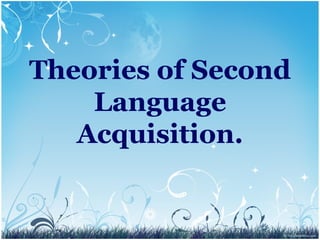
sla
- 1. Theories of Second Language Acquisition.
- 2. Theories • The Behaviourism Theory. • The Cognitive Theory. • The Creative Construction Theory. • The Second Language Interactionist View.
- 3. BEHAVIOURISM THEORY
- 4. BEHAVIOURISM Title THEORY • Psychoanalitic and Gestalt Movements • Ivan Pavlov • Edward LeeThordike • John B.Watson • B.F. Skinner
- 5. Hypotheses • Language is : Primarily spoken and secondly written ‘Mechanical Process’
- 6. Habit Formation -Positive Reinforcement Repetition and Imitaton -Linguistic Input Environment
- 7. Learned Patterns Interfere the Acquisition of a Second Language Patterns Contrastive analysis Hypothesis: Use knowledge already learned
- 8. Influence in Learning a First Language • Identifying points of similarity • Weighing evidence • Reflecting
- 10. Precursors Proposed by N.E.Miller J.Dollard. Expanded by Albert Bandura.
- 11. Cognocitive theory • Knowledge Acquisition •Observing others in Social Interactions.
- 12. Bandura’s Theory
- 13. Social Cognitive Theory Observing others Internal process that change behaviour Behave in certain ways to reach goals Self-directed
- 14. Interaction Interaction of knowledge New acquisition knowledge ‘fits’ and ‘restructure’. Restructure the first patterns system.
- 15. • Learning Efficacy close identification observer and the model. • Automatized vs restructured. • Which first language structures will be transfered and which not.
- 16. CREATIVE CONSTRUCTION THEORY
- 17. Creative construction Theory • It is propose by Stephen Krashen • It is also called as The Monitor Model • Learners are thought to “construct” internal representations of the language being learned
- 18. Differences between Acquisition and Learning Acquisition Learning implicit, subconscious explicit, conscious informal situations formal situations uses grammatical 'feel' uses grammatical rules depends on attitude depends on aptitude stable order of acquisition simple to complex order of learning
- 19. Creative Construction Theory The Acquisition – learning hypothesis. The Monitor hypothesis. The natural order hypothesis. The input hypothesis. The Affective Filter hypothesis.
- 20. The Acquisition– learning hypothesis. This hypothesis says that There are two independent systems The acquired system The learned system is is The product of a conscious The product of formal process. instruction and a conscious process. Krashen says that “learning” is less important than acquisition.
- 21. The Monitor hypothesis. Everyone has a monitor that tells them when something is good or bad. It requires these conditions: time, knowledge and focus on form. MONITOR Conditions (you need…) FOCUS TIME ON KNOWLEDGE FORM Have time to think. Know the rules (not Feel a need to use have forgotten it). the correct form.
- 22. The Monitor hypothesis. TYPES OF LEARNERS THAT USE THE MONITOR. Uses the monitor OPTIMAL MONITOR USER appropriately. Does not care about UNDER MONITOR USER correcting. Uses the monitor all the OVER MONITOR USER time.
- 23. The natural order hypothesis. This is a natural, predictable order in which people acquire language. It is the same for each person and independent of the instruction program.
- 24. The input hypothesis. People acquire a language by receiving camprehensible input. This input should be slighly ahead of a learner´s current state of knowledge( i + 1 ). 1 + INPUT i
- 25. The Affective Filter hypothesis. When the learner is experiencing high anxiaty, low- steem or low motivation, the filter turns on and causes the learner to block out input. FILTER HIGH FILTER INPUT INPUT LOW MOTIVATION MOTIVATION SELF - STEEM SELF - STEEM ANXIATY ANXIATY
- 26. Combined model of acquisition and production
- 27. The Second Language Interactionist view
- 28. Modified Input INTERACTIONISTS Affirm that Important role Decisive element L.A. Acquiring a mother tongue
- 29. Michael Long indispensable Comprehensible Language Input Acquisition
- 30. How Input is Concerning made comprehensible Focus Modified Input Necessary Interaction mecanism between native Communicating speakers and non-native speakers
- 31. essential Modified Language Interaction Acquisition Sumarized as Interactional Modifications make Input comprehensible. Comprehensible Input promotes acquisition. Interactional Modifications promotes acquisition.
- 32. applied • Native Non-Native Modify their linguistics6a00e54ee8552c883300e54f5c8feb8833 Speakers Speakers speech in -800wi.gif sustained conversations
- 33. Conversational modifications • Do you understand? Comprehension • Is this clear? • Do you see that..? Checks Native speaker makes sure that the learner understands
- 34. Clarification • Could you say that again? • Could you elaborate? Requests • What do you mean by this...? Native speaker clarifies something which has not been understood • You said ..... Repetition and • To put it differently or in another way, ... Paraphrasing • In other words, .... Native speaker repeats or paraphrases something which has not been understood
- 35. The more adjustments Native speaker makes in interaction with non- native speakers The more Input becomes comprehensible. facilitates Language Acquisition
- 36. Interaction focused on the effect Differents forms of feedback •Student: This red pencil. •Teacher: this is a red pencil. Direct Feedback Repeat after me •Student: This red pencil. Indirect Feedback •Teacher: Yes, this is a red pencil. It's not green, is it? What color is it? •Student: This is a red pencil.
